Page 26 of 416
26 At a glanceCenter consoleLower part
Item
Page
1
KEYLESS-GO* start / stop
button
33
2
Selector lever for
automatic transmission
43
3
PASSENGER AIRBAG OFF
indicator lamp
69
4
Thumbwheel for setting
distance in Distronic*
206
Item
Page
5
Distance warning func-
tion* on / off switch
206
6
Lower storage space
225
7
Program mode selector for
automatic transmission
164
Page 28 of 416
28 At a glanceDoor control panel
Door control panel
Item
Page
1
Door handle
94
2
Memory function (for stor-
ing seat, mirror, and steer-
ing wheel settings)
117
3
Seat heating*
Seat ventilation*
111
110
4
Seat adjustment
35
5
Exterior mirror adjustment
39,
168
6
Switches for opening/clos-
ing front door windows
188
7
Rear window override
switch
74
8
Switches for opening/clos-
ing rear windows
188
9
Remote trunk lid release
switch
Trunk lid opening/closing
system* switch
96
99
Page 34 of 416
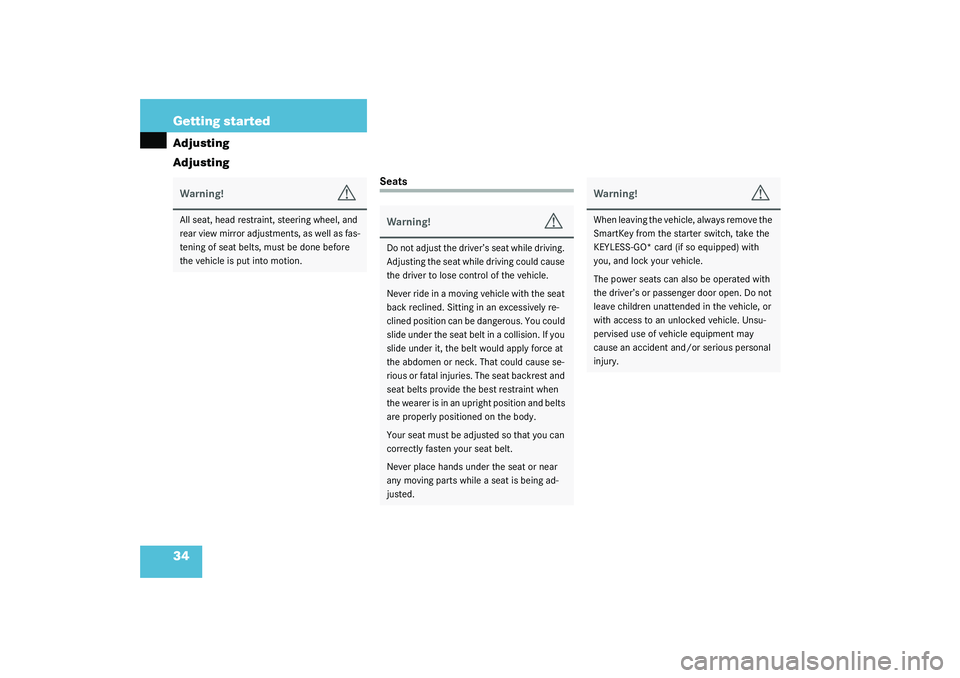
34 Getting startedAdjusting
Adjusting
Seats
Warning!
G
All seat, head restraint, steering wheel, and
rear view mirror adjustments, as well as fas-
tening of seat belts, must be done before
the vehicle is put into motion.
Warning!
G
Do not adjust the driver’s seat while driving.
Adjusting the seat while driving could cause
the driver to lose control of the vehicle.
Never ride in a moving vehicle with the seat
back reclined. Sitting in an excessively re-
clined position can be dangerous. You could
slide under the seat belt in a collision. If you
slide under it, the belt would apply force at
the abdomen or neck. That could cause se-
rious or fatal injuries. The seat backrest and
seat belts provide the best restraint when
the wearer is in an upright position and belts
are properly positioned on the body.
Your seat must be adjusted so that you can
correctly fasten your seat belt.
Never place hands under the seat or near
any moving parts while a seat is being ad-
justed.
Warning!
G
When leaving the vehicle, always remove the
SmartKey from the starter switch, take the
KEYLESS-GO* card (if so equipped) with
you, and lock your vehicle.
The power seats can also be operated with
the driver’s or passenger door open. Do not
leave children unattended in the vehicle, or
with access to an unlocked vehicle. Unsu-
pervised use of vehicle equipment may
cause an accident and/or serious personal
injury.
Page 36 of 416
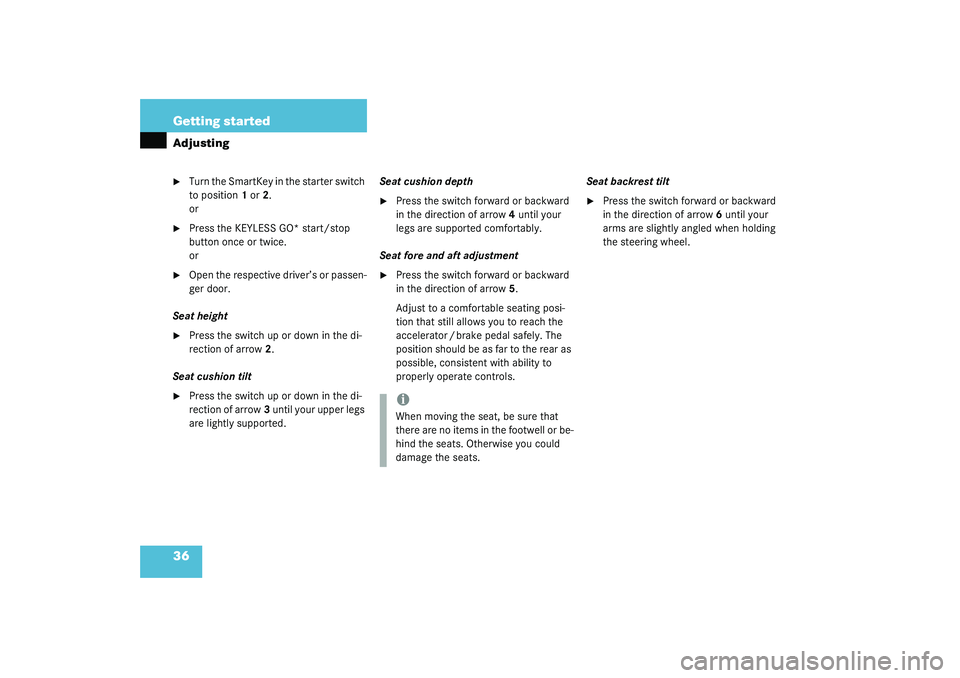
36 Getting startedAdjusting�
Turn the SmartKey in the starter switch
to position1or2.
or
�
Press the KEYLESS GO* start/stop
button once or twice.
or
�
Open the respective driver’s or passen-
ger door.
Seat height
�
Press the switch up or down in the di-
rection of arrow2.
Seat cushion tilt
�
Press the switch up or down in the di-
rection of arrow3 until your upper legs
are lightly supported.Seat cushion depth
�
Press the switch forward or backward
in the direction of arrow4 until your
legs are supported comfortably.
Seat fore and aft adjustment
�
Press the switch forward or backward
in the direction of arrow5.
Adjust to a comfortable seating posi-
tion that still allows you to reach the
accelerator / brake pedal safely. The
position should be as far to the rear as
possible, consistent with ability to
properly operate controls.Seat backrest tilt
�
Press the switch forward or backward
in the direction of arrow6 until your
arms are slightly angled when holding
the steering wheel.
iWhen moving the seat, be sure that
there are no items in the footwell or be-
hind the seats. Otherwise you could
damage the seats.
Page 37 of 416
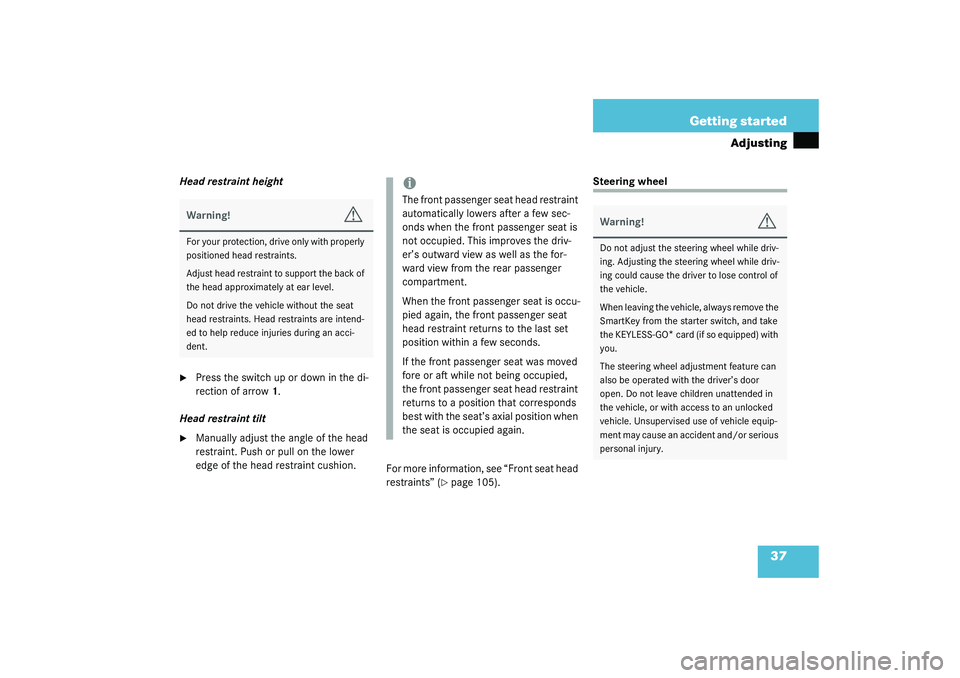
37 Getting started
Adjusting
Head restraint height�
Press the switch up or down in the di-
rection of arrow1.
Head restraint tilt
�
Manually adjust the angle of the head
restraint. Push or pull on the lower
edge of the head restraint cushion.
For more information, see “Front seat head
restraints” (
�page 105).
Steering wheel
Warning!
G
For your protection, drive only with properly
positioned head restraints.
Adjust head restraint to support the back of
the head approximately at ear level.
Do not drive the vehicle without the seat
head restraints. Head restraints are intend-
ed to help reduce injuries during an acci-
dent.
iThe front passenger seat head restraint
automatically lowers after a few sec-
onds when the front passenger seat is
not occupied. This improves the driv-
er’s outward view as well as the for-
ward view from the rear passenger
compartment.
When the front passenger seat is occu-
pied again, the front passenger seat
head restraint returns to the last set
position within a few seconds.
If the front passenger seat was moved
fore or aft while not being occupied,
the front passenger seat head restraint
returns to a position that corresponds
best with the seat’s axial position when
the seat is occupied again.
Warning!
G
Do not adjust the steering wheel while driv-
ing. Adjusting the steering wheel while driv-
ing could cause the driver to lose control of
the vehicle.
When leaving the vehicle, always remove the
SmartKey from the starter switch, and take
the KEYLESS-GO
* card (if so equipped) with
you.
The steering wheel adjustment feature can
also be operated with the driver’s door
open. Do not leave children unattended in
the vehicle, or with access to an unlocked
vehicle. Unsupervised use of vehicle equip-
ment may cause an accident and/or serious
personal injury.
Page 38 of 416
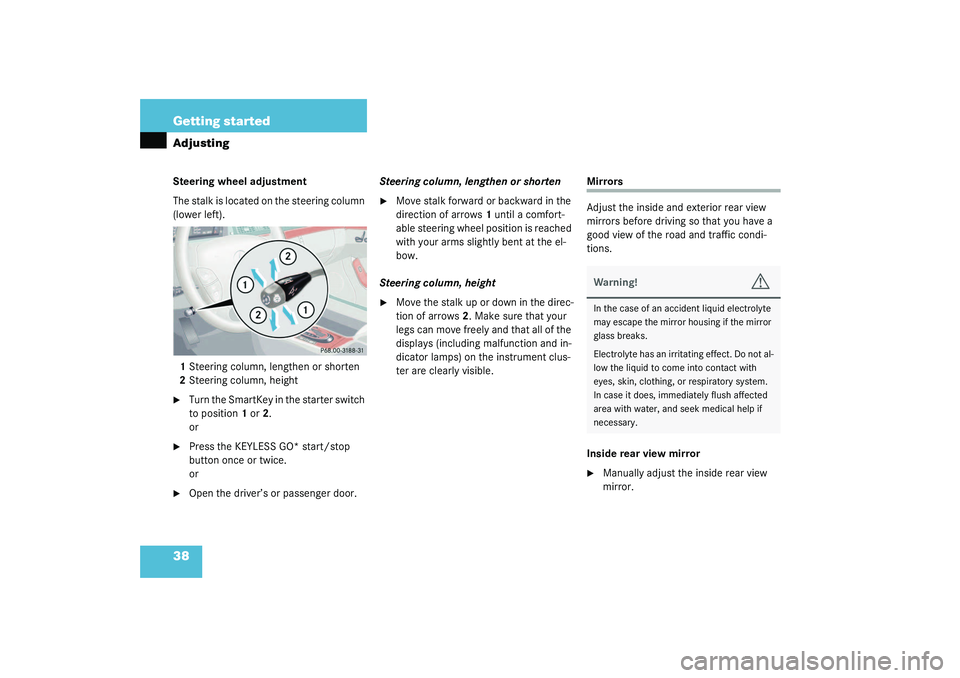
38 Getting startedAdjustingSteering wheel adjustment
The stalk is located on the steering column
(lower left).
1Steering column, lengthen or shorten
2Steering column, height�
Turn the SmartKey in the starter switch
to position1or2.
or
�
Press the KEYLESS GO* start/stop
button once or twice.
or
�
Open the driver’s or passenger door.Steering column, lengthen or shorten
�
Move stalk forward or backward in the
direction of arrows1 until a comfort-
able steering wheel position is reached
with your arms slightly bent at the el-
bow.
Steering column, height
�
Move the stalk up or down in the direc-
tion of arrows2. Make sure that your
legs can move freely and that all of the
displays (including malfunction and in-
dicator lamps) on the instrument clus-
ter are clearly visible.
Mirrors
Adjust the inside and exterior rear view
mirrors before driving so that you have a
good view of the road and traffic condi-
tions.
Inside rear view mirror�
Manually adjust the inside rear view
mirror.Warning!
G
In the case of an accident liquid electrolyte
may escape the mirror housing if the mirror
glass breaks.
Electrolyte has an irritating effect. Do not al-
low the liquid to come into contact with
eyes, skin, clothing, or respiratory system.
In case it does, immediately flush affected
area with water, and seek medical help if
necessary.
Page 45 of 416
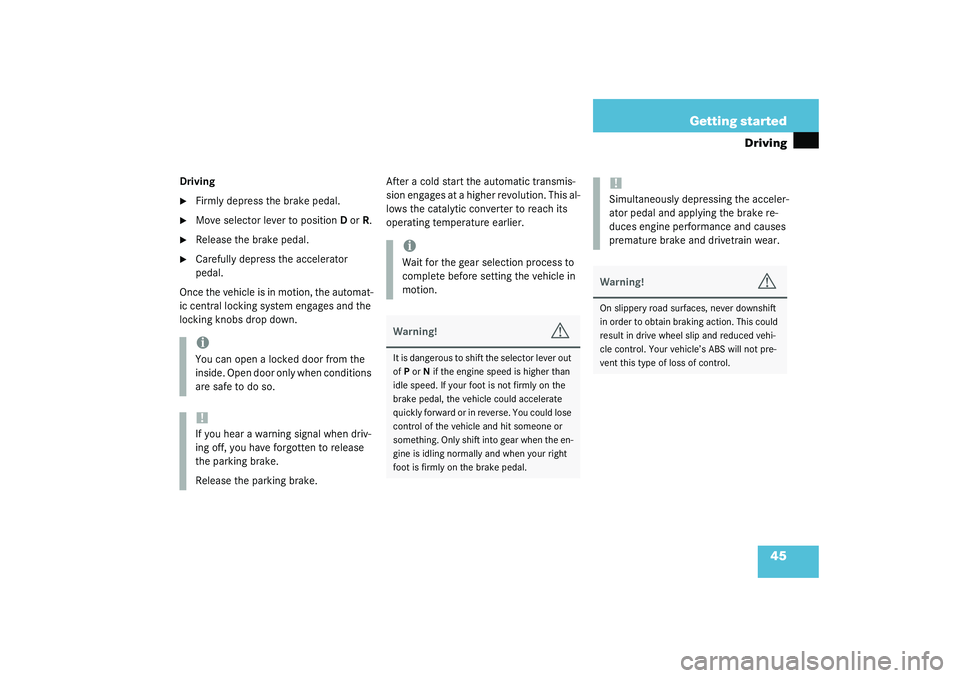
45 Getting started
Driving
Driving�
Firmly depress the brake pedal.
�
Move selector lever to positionDorR.
�
Release the brake pedal.
�
Carefully depress the accelerator
pedal.
Once the vehicle is in motion, the automat-
ic central locking system engages and the
locking knobs drop down.After a cold start the automatic transmis-
sion engages at a higher revolution. This al-
lows the catalytic converter to reach its
operating temperature earlier.iYou can open a locked door from the
inside. Open door only when conditions
are safe to do so.!If you hear a warning signal when driv-
ing off, you have forgotten to release
the parking brake.
Release the parking brake.
iWait for the gear selection process to
complete before setting the vehicle in
motion.Warning!
G
It is dangerous to shift the selector lever out
ofPorN if the engine speed is higher than
idle speed. If your foot is not firmly on the
brake pedal, the vehicle could accelerate
quickly forward or in reverse. You could lose
control of the vehicle and hit someone or
something. Only shift into gear when the en-
gine is idling normally and when your right
foot is firmly on the brake pedal.
!Simultaneously depressing the acceler-
ator pedal and applying the brake re-
duces engine performance and causes
premature brake and drivetrain wear.Warning!
G
On slippery road surfaces, never downshift
in order to obtain braking action. This could
result in drive wheel slip and reduced vehi-
cle control. Your vehicle’s ABS will not pre-
vent this type of loss of control.
Page 50 of 416
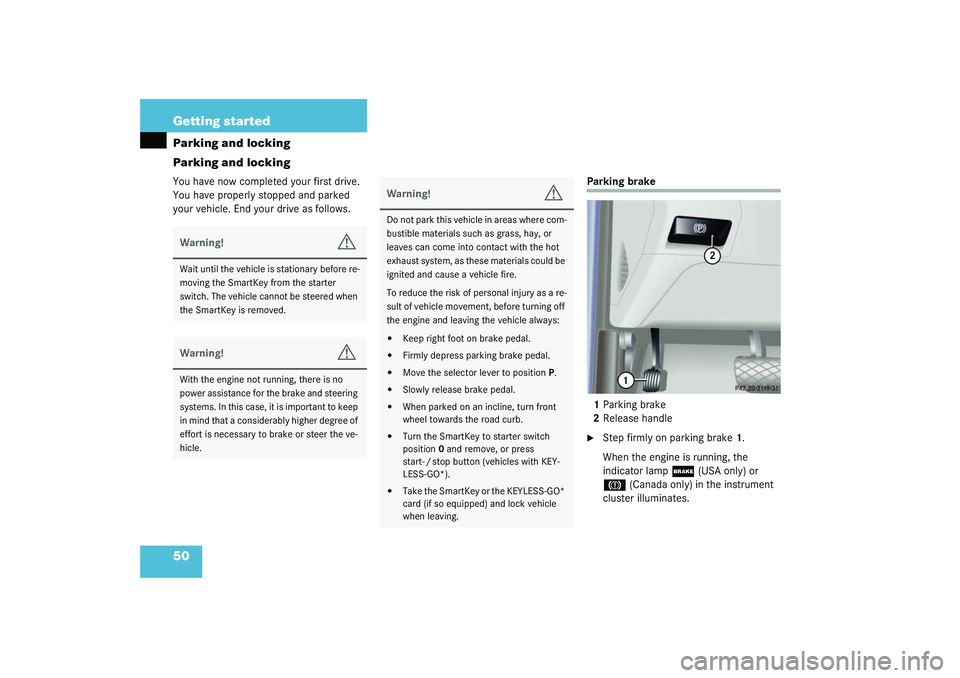
50 Getting startedParking and locking
Parking and lockingYou have now completed your first drive.
You have properly stopped and parked
your vehicle. End your drive as follows.
Parking brake
1Parking brake
2Release handle�
Step firmly on parking brake1.
When the engine is running, the
indicator lamp
;
(USA only) or
3
(Canada only) in the instrument
cluster illuminates.
Warning!
G
Wait until the vehicle is stationary before re-
moving the SmartKey from the starter
switch. The vehicle cannot be steered when
the SmartKey is removed.Warning!
G
With the engine not running, there is no
power assistance for the brake and steering
systems. In this case, it is important to keep
in mind that a considerably higher degree of
effort is necessary to brake or steer the ve-
hicle.
Warning!
G
Do not park this vehicle in areas where com-
bustible materials such as grass, hay, or
leaves can come into contact with the hot
exhaust system, as these materials could be
ignited and cause a vehicle fire.
To reduce the risk of personal injury as a re-
sult of vehicle movement, before turning off
the engine and leaving the vehicle always:�
Keep right foot on brake pedal.
�
Firmly depress parking brake pedal.
�
Move the selector lever to positionP.
�
Slowly release brake pedal.
�
When parked on an incline, turn front
wheel towards the road curb.
�
Turn the SmartKey to starter switch
position0 and remove, or press
start- / stop button (vehicles with KEY-
LESS-GO*).
�
Take the SmartKey or the KEYLESS-GO*
card (if so equipped) and lock vehicle
when leaving.